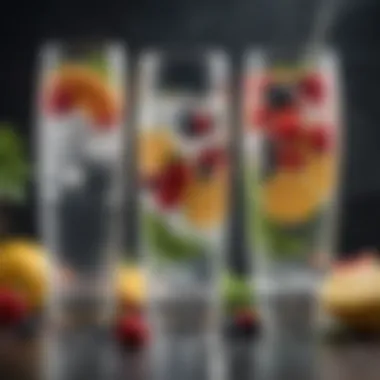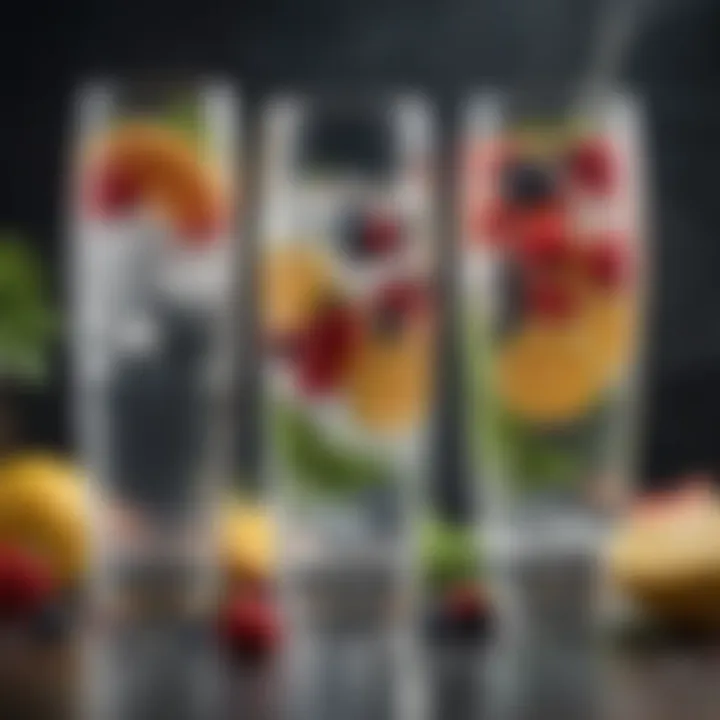The Rise of Sparkling Water: Trends and Insights


Intro
The popularity of sparkling water has surged in recent years. As health-conscious individuals seek alternatives to sugary beverages, this carbonated drink has gained a prominent place in everyday consumption. It offers a refreshing twist to hydration, often infused with various flavors that appeal to a wide range of palates. This article delves into the multifaceted world of sparkling water, examining its nutritional benefits, production methods, and the variety of options available on the market.
Sparkling water can be both a simple pleasure and a complex choice. From its mineral-rich variations to homemade syrups, there is much to explore in terms of preparing and enjoying this effervescent beverage. As we navigate through the specifics of sparkling water, we aim to shed light on the nuances that make it a staple in many diets and culinary practices.
"Sparkling water isn't just a drink; it is a lifestyle choice, intertwining health and taste preferences in modern living."
Nutritional Benefits
Sparkling water, especially those naturally sourced, can be a healthy alternative. It hydrates just like regular water, and many varieties contain minerals like calcium and magnesium. These minerals can play a role in daily dietary needs. Additionally, flavored sparkling waters often contain fewer or no calories compared to sodas, making them a better option for those watching their weight.
Varieties of Sparkling Water
The market offers numerous varieties of sparkling water, which include:
- Natural sparkling water: Sourced from mineral springs, contains natural carbonation and minerals.
- Carbonated spring water: Similar to natural options but with added carbonation to enhance effervescence.
- Flavored sparkling water: Infused with natural flavors or essences, often containing little or no added sugars.
- Tonic water: Contains quinine and often sugar, offering a unique taste profile.
Understanding these differences can help consumers make more informed choices based on their health and taste preferences.
Production Methods
The methods of producing sparkling water significantly impact its taste and mineral content. Natural spring water is bottled directly from the source, maintaining its unique flavor profile and mineral balance. In contrast, artificially carbonated water is produced by injecting carbon dioxide into still water. This process can dilute any natural minerals present, altering the flavor. Knowing the production method can assist consumers in selecting the right type for their needs.
Market Presence and Brand Overview
The sparkling water market has expanded greatly, with brands like LaCroix, Perrier, and Spindrift becoming household names. Each brand offers unique flavors and varieties, appealing to different consumer preferences. The growth of health-focused grocery stores has also contributed to the rising visibility of sparkling water on shelves.
Understanding Sparkling Water
Sparkling water has seen a remarkable rise in popularity. This trend reflects a shift in consumer preferences toward healthier beverage options. Understanding sparkling water involves examining its definitions, types, and nutritional aspects. This section aims to shed light on these subjects, allowing readers to unravel the complexities of sparkling water.
Definition and Types of Sparkling Water
Sparkling water is water that has been infused with carbon dioxide, creating its characteristic bubbles. The varieties of sparkling water can be categorized based on the source and processing methods.
Natural Sparkling Water
Natural sparkling water emerges from natural springs. The water is carbonated through geological processes. One key aspect is it retains essential minerals from the source. This makes it a popular choice for many consumers. Its unique feature is that the carbonation occurs naturally. It offers an effervescent experience without added chemicals. The advantages include its mineral content and pure taste. However, it might be less common and relatively more expensive than other types.
Carbonated Mineral Water
Carbonated mineral water is sourced from mineral springs and is artificially carbonated to increase fizziness. The defining characteristic is its mineral content, which varies according to the source. This choice is favorable for people seeking an added benefit from minerals like calcium and magnesium. Unlike other forms, its unique feature lies in the natural minerals that enhance flavor. The downside might be that some brands contain high levels of sodium, which could concern consumers.
Soda Water
Soda water is plain water carbonated by adding carbon dioxide. It is very versatile and often used as a mixer in drinks. The key characteristic is that it contains no added minerals. This provides an appealing choice for those who prefer a neutral taste. Its unique feature is that it can be flavored easily. While it serves as an excellent mixer, it may lack the specific health benefits that mineral water provides.
Sparkling Flavored Water
Sparkling flavored water is plain carbonated water with added natural or artificial flavors. It caters to those seeking variety in taste. The key characteristic is that it can be purchased in numerous flavors. This option is popular among consumers who wish to reduce sugar intake from sodas. A unique feature is its lower calorie count compared to sugary beverages. One disadvantage is it might contain artificial additives that some consumers prefer to avoid.
Nutritional Profile
The nutritional profile of sparkling water is essential for informing consumers about its health benefits. This includes understanding its caloric content, hydration benefits, and mineral presence.
Caloric Content
The caloric content of most sparkling water is minimal to none. This aspect makes it a beneficial choice for people watching their weight. Its popularity arises primarily from being calorie-free. Many brands do not add sugars or sweeteners, keeping it an excellent option for hydration. A critical advantage is its ability to satisfy the craving for carbonated drinks without adding extra calories.
Hydration Benefits
Sparkling water provides effective hydration due to its water content. This benefit is especially significant as staying hydrated is crucial for overall health. Many people find sparkling water more enjoyable than still water, promoting higher consumption rates. The unique feature is the carbonation, which may enhance the drinking experience. However, some individuals may experience bloating from the bubbles, leading to concerns about over-consumption.
Mineral Presence
The mineral presence in specific types of sparkling water adds to its appeal. Sparkling mineral water often has trace minerals beneficial for health. These minerals may include calcium, magnesium, and potassium. Such content can contribute positively to daily nutrient intake. The downside may include potential sodium content from certain brands, which can make it unsuitable for people on sodium-restricted diets.
Understanding these aspects of sparkling water informs consumers, allowing them to make choices that align with their health objectives.
The Process of Carbonation
Carbonation is a fundamental aspect of sparkling water, shaping its unique character. Understanding carbonation helps consumers appreciate the complexities behind their favorite effervescent drinks. This section explores the methods of carbonation and their influence on taste and texture, providing insight into why these processes matter.
Methods of Carbonation
Natural Carbonation
Natural carbonation occurs when spring water passes through mineral-rich underground rocks, absorbing carbon dioxide along the way. This natural infusion creates a gentle effervescence. The primary characteristic of natural carbonation is its spontaneity, relying on geological conditions rather than human intervention. Many regard this as a desirable quality because it connects the drinker to the source of the water.
This method results in a fine bubble structure, creating a pleasant, smooth mouthfeel. The bubbles are often perceived as less aggressive compared to artificially carbonated waters. However, natural carbonation is not universally available. The specific geological requirements limit where this water can be sourced, which can lead to a higher price point.
Pros of Natural Carbonation:
- Unique taste profile linked to the source.
- Potential mineral benefits.
Cons of Natural Carbonation:
- Availability can be limited.
- Cost may be higher.
Artificial Carbonation
Artificial carbonation involves dissolving carbon dioxide in water under pressure. This method allows for more control over the carbonation process. Its primary appeal lies in the ability to produce sparkling water in any location. Artificial carbonation is popular due to its cost-effectiveness and consistency in product.
The bubbles created through artificial means can vary in size and sensation, often resulting in a more pronounced, sharper fizziness. This robust characteristic can appeal to consumers looking for a refreshing burst of flavor. However, some individuals may find the sharpness overwhelming, which could affect their overall enjoyment.
Pros of Artificial Carbonation:
- Consistent product available globally.
- More approachable price point.


Cons of Artificial Carbonation:
- May lack the unique taste found in natural waters.
- Can produce an intense fizz that might not appeal to everyone.
Impact on Taste and Texture
The carbonation process has a significant impact on the overall drinking experience. Specifically, bubble size and sensation play an important role in how the beverage is perceived by consumers.
Bubble Size and Sensation
The size of the bubbles in sparkling water can dramatically influence the sensory experience. Smaller bubbles typically provide a smoother sensation as they pop gently on the palate. This characteristic can enhance the drink's overall drinkability, making it more enticing. Larger bubbles, in contrast, can create a sharper, more aggressive mouthfeel. Many consumers often associate larger bubbles with refreshing qualities, but this can be subjective.
In essence, the bubble size contributes to the overall enjoyment of the drink, offering a tactile experience that complements flavor.
Considerations of Bubble Size and Sensation:
- Smaller bubbles lead to a smooth drinking experience.
- Larger bubbles can convey refreshment and liveliness.
Influence on Flavor Perception
The presence of carbonation not only adds effervescence but can also enhance or alter flavor perception. Carbon dioxide can interact with the taste buds, amplifying certain flavors while dampening others. For example, acidity can become more pronounced in carbonated beverages.
This interaction has led to interesting developments in flavor profiles for sparkling water, as brands experiment with diverse flavor infusions. By understanding how carbonation impacts flavor perception, consumers can better select their preferred varieties of sparkling water.
Factors in Flavor Perception:
- Carbonation can amplify acidity and brightness of flavor.
- The interaction between bubbles and taste buds influences individual preferences.
"The interplay between carbonation and flavor perception is crucial for enhancing the enjoyment of sparkling water."
Popular Brands in the Market
The exploration of popular brands in the sparkling water market reflects not only consumer trends but also shapes perceptions and choices regarding this effervescent beverage. Established brands often set the benchmarks for quality while emerging brands introduce fresh ideas and innovative flavors. Understanding these brands can help consumers make informed decisions about their beverage choices, particularly when considering taste, health benefits, and sustainable practices.
Established Brands
San Pellegrino
San Pellegrino, a brand renowned for its natural mineral water sourced from the San Pellegrino Terme area in Italy, is a staple in the sparkling water category. The key characteristic of this brand is its fine balance of minerals, which contributes to its distinctive flavor profile. The effervescence is well-matched with the mineral content, providing a crisp and refreshing experience suitable for both casual drinking and fine dining. This brand stands out for offering not just hydration, but a taste that enhances culinary experiences.
San Pellegrino’s unique feature is its versatile pairing ability with various foods. It is often recommended with meals, enhancing flavors without overpowering them. However, one consideration is its higher sodium content compared to other sparkling waters, which might not appeal to those monitoring their salt intake.
Gerolsteiner
Gerolsteiner, sourced from the volcanic region of Gerolstein in Germany, offers another significant option in the sparkling market. Known for its balanced mineral content, Gerolsteiner is often favored for its health benefits, particularly its high calcium and magnesium levels. This makes it a beneficial choice for individuals looking to enhance their mineral intake.
The unique feature of Gerolsteiner is its natural carbonation, which leads to a more refined taste profile. This brand positions itself well in the health-conscious segment, appealing to those who appreciate both flavor and nutritional value. However, its taste may not cater to everyone, especially those preferring a milder fizz.
Perrier
Perrier is synonymous with luxury in the sparkling water world. Originating from the Vergèze spring in France, this brand is recognized for its bold bubbles and refreshing taste. Perrier's key attribute is its unique carbonation process, which produces larger bubbles that create a lively drinking experience. The brand is often associated with wellness and sophistication, frequently featured in upscale settings.
Perrier’s distinct feature is its green glass bottle, which emphasizes its premium status. While its unique taste can elevate the drinking experience, some consumers find its high mineral content to be slightly overpowering. Therefore, it's essential to weigh these factors when choosing Perrier.
Emerging Brands
Spindrift
Spindrift represents an innovative approach within the sparkling water market, as it uses real fruit juice to flavor its products. This brand is notable for its simplicity and transparency regarding ingredients. The key characteristic of Spindrift is the authenticity of its flavors, which appeal to consumers seeking natural options without artificial additives.
The unique feature of Spindrift is its commitment to whole ingredients, providing flavors that are sourced from real fruit. This adds a layer of taste complexity absent in typical flavored sparkling waters. However, the inclusion of juice means that Spindrift has a slightly higher caloric content compared to traditional sparkling waters.
Bubly
Bubly has emerged as a vibrant player in the sparkling market, catering to a younger audience with its energetic branding and refreshing flavors. Bubly stands out with its fun, colorful cans and a variety of flavors, which makes it appealing for casual consumption. The key element of Bubly is its commitment to being calorie-free while providing a broad spectrum of exciting tastes.
The unique aspect of Bubly is its focus on accessibility and enjoyment. However, it's essential to note that the abundance of artificial sweeteners may not suit everyone’s preferences, particularly those looking for natural products.
Polar Seltzer
Polar Seltzer carries a legacy of over a century in the sparkling water market. This brand has gained recognition for its wide array of flavors and commitment to quality. The primary characteristic of Polar Seltzer is its accessibility and affordability, making it a favorite among consumers seeking value without sacrificing taste.
The unique feature of Polar is its creative seasonal flavors, which often captivate loyal customers. Despite this, some consumers might find that the taste can be less pronounced than that of other brands, which could affect overall satisfaction.
"The expansion of sparkling water options reflects a growing consumer desire for healthier and flavorful alternatives to traditional soft drinks."
Understanding these popular brands helps consumers navigate the crowded sparkling water landscape. Whether drawn to the established prestige of San Pellegrino or the refreshing innovation of Spindrift, each offers distinct experiences that cater to various preferences and needs.
Flavor Innovations
Flavor innovations play a crucial role in the appeal and popularity of sparkling water. As consumers seek diverse and exciting options, these innovations serve not just to entice the palate, but also to meet evolving preferences for health and wellness. Enhanced flavor choices allow brands to differentiate themselves in a competitive market. This section explores significant trends in flavoring, highlighting popular choices and how they cater to consumer demands.
Trends in Flavoring
Citrus and Berry Flavors
Citrus and berry flavors stand out in the realm of sparkling water. These flavors are characterized by their refreshing and vibrant notes, which can enliven a dull drinking experience. Citrus flavors, such as lemon and lime, offer a tangy profile that can complement the natural fizz. Berry flavors, like raspberry and strawberry, add sweetness without the need for added sugars. This combination makes them a popular choice for many consumers looking for something enjoyable yet not overly indulgent. The use of these flavors often appeals to those seeking a burst of refreshment, particularly in warmer months.
However, one consideration is that citrus and berry flavors can vary significantly in intensity among different brands. Some may use natural extracts, while others might rely on artificial flavoring. The choice between these options can influence taste and consumer perception of quality, which is an essential aspect for any product in today's market.
Exotic Ingredients
The use of exotic ingredients in sparkling water flavors enriches the experience for adventurous consumers. Flavors derived from unique fruits like dragon fruit or jackfruit introduce a new layer of complexity and intrigue. These ingredients can also attract consumers looking for novel sensations, pushing the boundaries of traditional beverage choices.
The key characteristic of using exotic ingredients is their ability to provide a distinctive flavor profile, which may resonate with those interested in global flavors. However, obtaining these ingredients can present challenges. They may be more expensive or less accessible than common flavorings. Therefore, brands must find a balance between uniqueness and practicality when incorporating exotic ingredients into their offerings.
Herbal and Floral Notes
Herbal and floral notes bring a sophisticated twist to the sparkling water landscape. Flavors such as lavender, mint, or basil can create a soothing or refreshing profile that appeals to a more mature audience. These flavors often suggest a premium product, catering to consumers who desire a more nuanced experience.
Emphasizing natural wellness trends, herbal and floral notes align well with health-focused consumers. Yet, a challenge presents itself: not all consumers are familiar with these flavors, which may limit their acceptance. Education and effective marketing can play pivotal roles in overcoming this barrier, ensuring that consumers understand and appreciate the value of these unique offerings.


Consumer Preferences
Shifts in consumer tastes reflect broader trends in health consciousness, leading to specific preferences in flavor choices. Understanding these trends is vital for producers aiming to align their products with customer expectations.
Growing Demand for Natural Flavors
The growing demand for natural flavors signifies a notable shift in consumer preferences. Many people are increasingly wary of artificial additives and seek beverages that provide transparency in their ingredients. This trend is beneficial, as it encourages brands to focus on quality and sustainability.
Natural flavors often elicit trust. Knowing that a product contains real ingredients can enhance consumer satisfaction and potentially lead to brand loyalty. However, sourcing these ingredients may impose higher production costs on companies, which may need to be reflected in product pricing.
Preference for Low-Calorie Options
As the focus on health intensifies, the preference for low-calorie options continues to influence sparkling water trends. Consumers aim to enjoy flavorful beverages without excessive caloric intake. This preference has led to the production of sparkling waters that minimize calories while maximizing taste.
The unique feature of low-calorie options is the ability to provide enjoyment without guilt. However, brands must be careful about balancing flavor and health. Some may resort to natural sweeteners, which can alter taste significantly. Striking a balance remains crucial in this competitive landscape.
Health Considerations
Health considerations surrounding sparkling water are crucial, especially in today's health-conscious society. There is a growing preference for beverages that promote hydration while minimizing negative health impacts. Sparkling water offers a compelling alternative to traditional soft drinks and sugary juices, making its inclusion in discussions about healthy lifestyle choices significant. Individuals looking for better hydration solutions, lower calorie intake, and improved digestive health will find these considerations particularly relevant.
Comparing Sparkling Water to Other Beverages
Soft Drinks
Soft drinks are often characterized by high sugar content and artificial additives. This gives them a unique flavor profile, but they also contribute to issues such as weight gain and dental problems. The high calorie load is a significant drawback for those monitoring their intake. Sparkling water, in contrast, provides a bubbly texture without added sugars and calories, appealing to consumers aiming for healthier choices.
The effervescence of soft drinks might create a satisfying sensation, yet the negative health implications are increasingly recognized. This shift highlights the value of sparkling water as a healthier option in personal beverage choices.
Juices and Sugary Beverages
Juices and sugary beverages usually present themselves as healthier options, often marketed for their vitamin content. However, many contain high levels of natural sugars which can lead to excessive calorie consumption and spike in blood sugar levels. Sparkling water, on the other hand, offers hydration with virtually no calories or sugar. This makes it a more suitable choice for those conscious of their sugar intake while still enjoying a refreshing drink.
The unique feature of sparkling water in this comparison is its ability to provide sensory satisfaction without the drawbacks associated with sugary beverages. For anyone considering their daily fluid intake, sparkling water indeed stands as a favorable alternative.
Potential Health Benefits
Enhanced Hydration
Enhanced hydration is one of the defining benefits of consuming sparkling water. Proper hydration is essential for various bodily functions, including regulating temperature, maintaining joint health, and supporting overall bodily functions. Sparkling water, with its appealing fizz, encourages increased fluid consumption in a way that still concerns about taste and enjoyment.
The key characteristic of enhanced hydration from sparkling water is its ability to quench thirst effectively. Drinking plain water can become tedious; the addition of bubbles can make hydration less of a chore, which is beneficial for maintaining an adequate hydration routine.
Satiety and Digestion
Satiety and digestion are crucial aspects of health that sparkling water can positively influence. The carbonation in sparkling water can create a feeling of fullness, which may help reduce overall calorie intake at meals. Individuals often find that consuming sparkling water before or during meals leads to less overall food consumption.
Moreover, bubbly drinks can aid digestion by promoting the release of gases and helping move food through the gastrointestinal tract. This unique feature positions sparkling water as a practical choice for those seeking to balance their dietary habits while supporting digestive health.
Understanding these health considerations provides valuable insights for consumers looking to make informed beverage choices.
Culinary Uses of Sparkling Water
The culinary uses of sparkling water extend beyond mere refreshment. Its effervescence and unique properties offer a variety of applications in both cooking and mixology. Sparkling water can enhance the flavors of dishes, alter textures, and provide a low-calorie alternative to other ingredients. Understanding these uses can help home cooks and professional chefs alike to elevate their dishes and beverages.
In Cooking
Carbonated Breads
Carbonated breads are a fascinating application of sparkling water in cooking. The bubbles in the sparkling water create a light and airy texture in the dough. This results in a bread that is softer and has a more desirable crumb structure. Many bakers find that using sparkling water can help improve the rise of bread without adding additional yeast.
The key characteristic of carbonated breads lies in their texture. It is a beneficial choice for individuals seeking to create lighter breads without the lengthy fermentation process. However, this method requires careful handling. Too much carbonation can lead to a overly sticky dough, which can make the kneading process challenging. Despite this, the lightness achieved is often viewed as a significant advantage.
Fry Batter Enrichment
Fry batter enrichment through sparkling water is another popular use. The carbonation can create a batter that is crispy and airy, providing a delightful contrast to fried foods. This is particularly popular in dishes such as tempura or beer-battered fish. The bubbles in the water do not only provide texture; they also help the batter adhere and form a crust.
The primary characteristic is its ability to lighten the batter, which is very beneficial when frying. A lighter batter absorbs less oil, resulting in a crispier and more enjoyable fried item. However, it is important to use the sparkling water immediately after opening; otherwise, the carbonation can dissipate, leading to a denser batter.
In Mixology
Classic Cocktails
Sparkling water plays a pivotal role in many classic cocktails. Many drink recipes call for a splash of sparkling water to elevate the drink's refreshing qualities. The effervescence enhances flavors and adds a lively texture that can make a simple drink feel more complex and enjoyable.
The unique feature of classic cocktails that include sparkling water is their versatility. They can be easily adapted to suit various tastes by adjusting the proportions of the water to the other ingredients. This characteristic makes them a popular choice for entertaining. However, the use of sparkling water can sometimes dilute the drink's flavor if not balanced correctly.
Mocktails and Refreshing Beverages
Mocktails represent a growing trend where sparkling water serves as an ideal base. They provide a refreshing and guilt-free alternative to traditional cocktails. By combining sparkling water with fruit juices and herbs, one can create an array of vibrant, non-alcoholic beverages that appeal to a wide audience.
The key characteristic of mocktails is their ability to maintain a festive atmosphere without the alcohol. This makes them an inclusive option for social gatherings. However, achieving the right balance of flavors can be tricky. Too much sparkling water can overpower the other ingredients, leaving a less satisfying overall taste. Thoughtful combinations are essential for success.
Overall, sparkling water serves as a multifunctional ingredient in both cooking and mixology, providing texture, flavor enhancement, and creativity in culinary applications. Understanding its uses can significantly enhance both home and professional cooking experiences.
Sustainability Practices
Sustainability in sparkling water production and consumption is becoming a critical focus in today’s environmentally conscious world. This section addresses the key aspects of sustainability practices in the industry. Companies are increasingly aware of their ecological footprint and are taking steps to minimize it. By focusing on eco-friendly packaging, sourcing ingredients responsibly, and implementing reduction strategies, the sparkling water market aims to align with global sustainability goals. This not only benefits the environment but also appeals to consumers who prioritize eco-conscious products.
Eco-Friendly Packaging
Appleton Eco-Friendly Packaging refers to using materials that are either recyclable or reusable. This practice is significant for several reasons. It limits the amount of waste produced and can help reduce landfill contributions. Moreover, using recyclable materials can enhance brand image and attract environmentally-conscious consumers.
Recyclable Materials
Recyclable materials are those that can be processed and turned into new products after their initial use. This characteristic makes them appealing in sparkling water production. The use of plastic bottles that are recyclable, such as PET (polyethylene terephthalate), is a popular choice. The unique feature of recyclable materials is their ability to re-enter the supply chain, thereby reducing the need for virgin resources.
The advantages of recyclable materials include reducing waste and conserving resources. However, challenges exist, such as ensuring consumers actually recycle the products. Sometimes, the recycling systems could be inefficient, causing materials not to be reused.
Bottle and Can Reduction Strategies
Bottle and can reduction strategies focus on minimizing waste generated during the packaging lifecycle. Companies are shifting towards using fewer materials in their packaging or opting for larger containers to decrease individual servings.


This strategy emphasizes resource efficiency. The unique feature lies in the design of the packaging itself, which can be optimized for transport and storage, thereby reducing its environmental impact.
The advantages of reducing bottles and cans include less resource consumption at the start and reduced waste at the end of the lifecycle. However, there are disadvantages as well; sometimes, larger packages may not be practical for all consumers, like those living alone or with limited storage space.
Sourcing of Ingredients
Sourcing of ingredients is a crucial aspect of sustainability practices. How, where, and under what conditions raw materials are obtained can significantly impact the overall sustainability of sparkling water products.
Regional Sourcing Practices
Regional sourcing practices emphasize the selection of ingredients that are produced nearby. This approach can be beneficial for several reasons. It reduces transportation emissions, as shorter distances often mean lower carbon footprints. Moreover, local economies can benefit from supporting nearby producers.
A unique feature of regional sourcing is the promotion of seasonal and local flavors. This can enhance the product’s uniqueness and appeal. The advantages include fresher ingredients and community support. Disadvantages might include limitations in variety or availability of ingredients depending on local climates.
Environmental Impact Considerations
Environmental impact considerations involve analyzing the effects of sourcing ingredients on ecosystems and communities. This factor is essential to ensure that practices do not lead to degradation of natural resources or harm local habitats.
Companies can manage these factors by seeking certifications or adhering to sustainable sourcing guidelines. A unique characteristic of this consideration is the balance between production practices and environmental stewardship. The advantages include protecting ecosystems and promoting biodiversity. Disadvantages can arise when rigorous standards limit the availability of certain products or increase costs.
"Choosing sustainable practices in sparkling water production is not just a trend; it’s a necessity for the health of our planet and future generations."
Marketing and Branding Strategies
Marketing and branding strategies play a crucial role in the success of sparkling water products. As the beverage market grows, brands must communicate effectively with consumers to differentiate themselves. These strategies are not only about promoting a product; they encapsulate the values, promise, and personality of the brand. Attention to marketing allows brands to connect emotionally with consumers while building trust and loyalty.
Target Demographics
Health-Conscious Individuals
Health-conscious individuals represent a significant segment of the sparkling water market. This group often prioritizes wellness and hydration over sugary beverages. A key characteristic of these consumers is that they actively seek alternatives that support their health goals. Sparkling water is low in calories, making it an attractive choice. Its unique feature is the carbonation, which provides a satisfying sensation without added sugars. The advantage of targeting this demographic is its potential for driving sales through the growing interest in healthier lifestyle choices.
Millennials and Generation Z
Millennials and Generation Z are also pivotal demographics for sparkling water brands. These consumers tend to value authenticity and sustainability in their purchasing decisions. They are often drawn to brands that align with social and environmental issues. The unique feature of these generations is their heavy social media usage. This allows brands to engage directly and showcase their offerings in innovative ways. The advantage is a higher degree of brand awareness and loyalty; however, these demographics also demand transparency and consistency from the brands they support.
Advertising Campaigns
Social Media Strategies
Social media strategies are essential for the marketing of sparkling water. They allow brands to reach vast audiences quickly and effectively. A key characteristic of social media is its interactive nature, providing space for brands to engage with consumers directly. This choice is beneficial as it can lead to instant feedback and community building around the brand. A unique aspect is the viral potential of social media content, which can significantly increase brand visibility. The downside could be the need for constant engagement, which requires substantial resources and creativity.
Influencer Partnerships
Influencer partnerships emerged as a strong marketing strategy for sparkling water brands. These collaborations can effectively tap into the established trust that influencers have with their followers. A key characteristic of these partnerships is authenticity; influencers often present products in a relatable context. This is beneficial for brands as it can improve reach and conversion rates. However, the challenge lies in selecting the right influencers whose values align with the brand's message. A misalignment may lead to negative perceptions and a lack of credibility.
Global Trends in Sparkling Water Consumption
The increasing popularity of sparkling water reflects significant developments in consumer preferences and market dynamics. This section examines the vital global trends shaping the consumption of sparkling water, revealing insights into health consciousness, regional preferences, and evolving market strategies. Understanding these trends sheds light on the growing significance of sparkling water as a mainstream beverage choice.
Market Growth Statistics
Regional Variations
Regional variations are contributing significantly to the growth of sparkling water markets. Different regions around the world display distinctive preferences regarding flavors, types, and consumption habits. For instance, Europe, known for its cultural affinity for natural mineral waters, shows a strong inclination towards products like San Pellegrino and Perrier. In contrast, North America trends towards flavored carbonated options like Bubly and Spindrift.
Each region has its own characteristic taste profiles. In Europe, consumers strongly prefer lightly flavored or unflavored sparkling waters, valuing their mineral content. Meanwhile, in America, the interest is shifting towards flavored and innovative products that provide a refreshing alternative to sugary beverages. This regional diversity influences the overall market landscape, making it crucial for brands to adapt their offerings to cater to specific consumer demands in different areas.
Impact of Health Trends
The impact of health trends on sparkling water consumption is noteworthy. With a rising number of health-conscious individuals turning away from sugary sodas, sparkling water serves as a favorable substitute. It has no calories and can often provide essential minerals, appealing to consumers focused on hydration without guilt.
Moreover, the trend of healthier lifestyles pushes brands to market their products as beneficial. This includes advocating for the hydration benefits of sparkling water, showcasing its role in a balanced diet, and emphasizing natural ingredients. Such marketing strategies reinforce the appeal of sparkling water, positioning it as a desirable choice in a health-centric marketplace.
Cultural Preferences
European Preferences vs. American Trends
Cultural preferences in sparkling water consumption reveal interesting contrasts between Europe and America. In Europe, sparkling water is often consumed with meals, viewed as a sophisticated beverage that complements food. This tradition supports the consumption of natural mineral waters that offer unique taste profiles based on their source.
On the other hand, American trends lean towards convenience and experimentation. Sparkling waters are frequently consumed on-the-go and used in casual settings. The American market sees a higher demand for flavored variants, showcasing a desire for variety and innovation. This cultural divergence highlights the importance of tailoring marketing strategies based on regional nuances to meet the preferences of different consumer groups.
Emerging Markets
Emerging markets are becoming increasingly important in the global sparkling water scene. Countries like India and Brazil are witnessing a surge in sparkling water consumption, driven by urbanization and a growing middle class. Younger consumers in these markets show a willingness to explore new beverage categories, making them lucrative opportunities for brands.
The potential of emerging markets also presents challenges. Brands must navigate diverse regulatory environments and adapt to local tastes. Effective marketing that resonates with local cultures is crucial for success. Building awareness around the health benefits of sparkling water will further enhance its appeal, leading to sustainable growth in these regions.
"As sparkling water becomes synonymous with a healthful lifestyle, brands must stay attuned to changing consumer preferences and market dynamics globally."
In summary, the global trends in sparkling water consumption reveal regional differences, health influences, cultural preferences, and growth opportunities in emerging markets. By understanding these elements, stakeholders can strategize effectively, ensuring the continued success of sparkling water as a favored beverage in the modern marketplace.
Culmination and Future Outlook
In this article, we have dissected the multifaceted world of sparkling water, illuminating its various dimensions ranging from health benefits to market trends. This final section serves as a synthesis of the primary takeaways while glancing into the horizon for future developments. Understanding the role of sparkling water is not only crucial for consumers but also for industry stakeholders who are navigating this dynamic market.
Key Takeaways
Understanding Sparkling Water
The essence of understanding sparkling water lies in recognizing its diverse forms and health qualities. Sparkling water is not merely a carbonated alternative to still water; it comes in various types, including natural sparkling and flavored variants. The key characteristic of sparkling water is its broad appeal, satisfying the thirst for refreshment while often providing a healthier option than sugary beverages. Each type offers unique advantages: for instance, natural sparkling water contains minerals that can contribute to daily nutrient intake. This variety makes it a beneficial choice that aligns well with diverse dietary preferences.
Health Benefits and Culinary Applications
Exploring health benefits and culinary applications reveals another layer of versatility in sparkling water. The hydration benefits of sparkling water are notable. It can be a refreshing substitute in recipes, such as enhancing the texture of certain batters. Moreover, the low-calorie nature of most sparkling waters makes them attractive for those monitoring their caloric intake. However, a unique feature to consider is the carbonation level, which can vary among brands. This can affect how it interacts with food and its overall mouthfeel, influencing a consumer's choice.
The Future of Sparkling Water
Potential Innovations
The future of sparkling water promises exciting innovations that could reshape consumer experiences. Emerging technologies in carbonation may enhance flavor profiles, allowing manufacturers to experiment with new and unique offerings that attract a broader audience. The focus on health consciousness among consumers is also likely to drive brands to create products that further emphasize natural and organic ingredients, keeping them relevant in a competitive market.
Sustainability in Production
Sustainability in production will play a pivotal role moving forward. Companies are under increasing pressure to adopt eco-friendly practices. The use of recyclable materials for packaging and minimizing waste will be essential. This characteristic does not just benefit the environment but also aligns with consumer values, especially among younger demographics who prioritize sustainability. Each innovation in sustainability presents a unique challenge as well as an advantage in promoting a greener approach to the production and consumption of sparkling water.
"Sparkling water is more than just a beverage; it is a reflection of our evolving tastes and values, bridging the gap between health-conscious choices and sustainability efforts."







